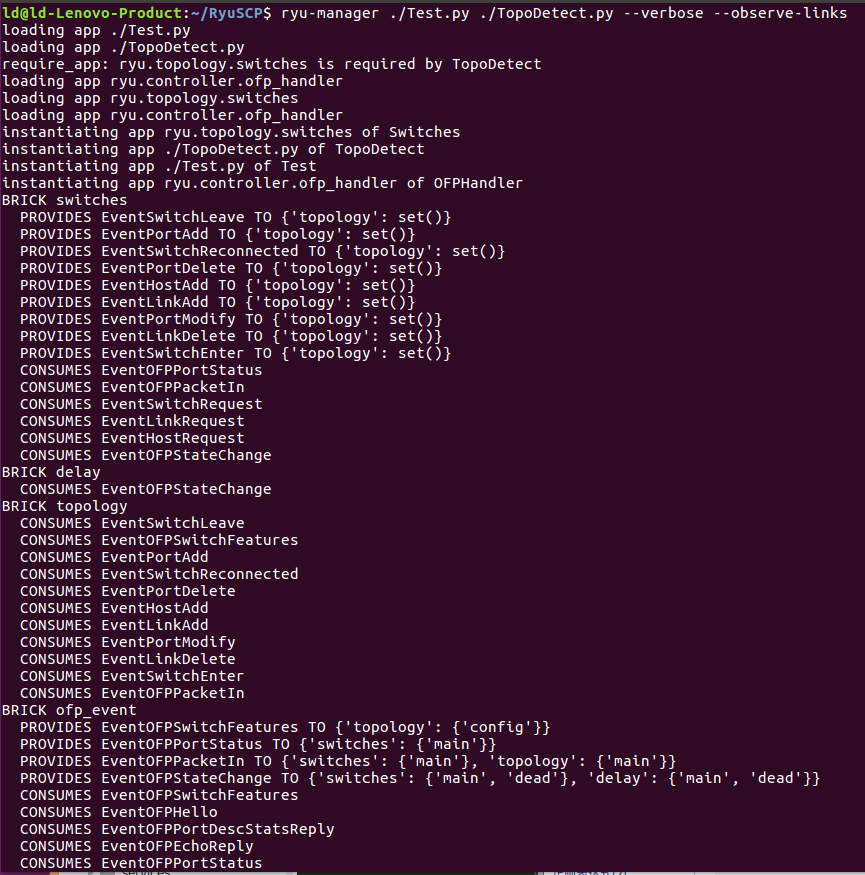Ryu源码之模块功能分析
一:模块间通信机制分析
Ryu是一款非常轻便的SDN控制器,在科研方面得到了广泛的应用。相比其他控制器,受益于Python语言,在Ryu上开发SDN应用的效率要远高于其他控制器。为了解决复杂的业务,有时需要在Ryu上开发多模块来协同工作,从而共同完成复杂的业务。这里只考虑lookup_service_brick获取模块实例对象,从而获取动态实例对象的数据!!!
以:SDN实验---Ryu的应用开发(五)网络拓扑发现为例(TopoDetect.py),作为自定义的app,被加载到一个新的app中(Test.py)
(一)使用lookup_service_brick加载模块实例时,对于我们自己定义的app(需要被加载的),我们需要在类中定义self.name。

(二)源码分析: 查看如何使用self.name
参考:SDN实验---Ryu的源码分析
1.从main入口查找:ryu/cmd/manager.py
from ryu.base.app_manager import AppManager
def main(args=None, prog=None):
app_lists = CONF.app_lists + CONF.app #从ryu-manager传入的App参数中获取app_list (详细可看参考)---重点:我们需要同时将被加载的类传入
app_mgr = AppManager.get_instance() #单例对象,管理所有的app app_mgr.load_apps(app_lists) #加载所有app:重点 contexts = app_mgr.create_contexts() #创建上下文 services = [] services.extend(app_mgr.instantiate_apps(**contexts)) #重点:实例化app----下一步分析 webapp = wsgi.start_service(app_mgr) if webapp: thr = hub.spawn(webapp) services.append(thr) try: hub.joinall(services) except KeyboardInterrupt: logger.debug("Keyboard Interrupt received. " "Closing RYU application manager...") finally: app_mgr.close()
2.app_mgr.instantiate_apps实例化app : ryu.base.app_manager
class AppManager(object): def load_app(self, name): mod = utils.import_module(name) clses = inspect.getmembers(mod, lambda cls: (inspect.isclass(cls) and issubclass(cls, RyuApp) and mod.__name__ == cls.__module__)) if clses: return clses[0][1] return None def load_apps(self, app_lists): app_lists = [app for app in itertools.chain.from_iterable(app.split(',') for app in app_lists)] while len(app_lists) > 0: app_cls_name = app_lists.pop(0) context_modules = [x.__module__ for x in self.contexts_cls.values()] if app_cls_name in context_modules: continue LOG.info('loading app %s', app_cls_name) cls = self.load_app(app_cls_name) if cls is None: continue self.applications_cls[app_cls_name] = cls services = [] for key, context_cls in cls.context_iteritems(): v = self.contexts_cls.setdefault(key, context_cls) assert v == context_cls context_modules.append(context_cls.__module__) if issubclass(context_cls, RyuApp): services.extend(get_dependent_services(context_cls)) # we can't load an app that will be initiataed for # contexts. for i in get_dependent_services(cls): if i not in context_modules: services.append(i) if services: app_lists.extend([s for s in set(services) if s not in app_lists]) def instantiate_apps(self, *args, **kwargs): for app_name, cls in self.applications_cls.items(): self._instantiate(app_name, cls, *args, **kwargs) self._update_bricks() self.report_bricks() threads = [] for app in self.applications.values(): t = app.start() if t is not None: app.set_main_thread(t) threads.append(t) return threads def _instantiate(self, app_name, cls, *args, **kwargs): # for now, only single instance of a given module # Do we need to support multiple instances? # Yes, maybe for slicing. LOG.info('instantiating app %s of %s', app_name, cls.__name__) if hasattr(cls, 'OFP_VERSIONS') and cls.OFP_VERSIONS is not None: ofproto_protocol.set_app_supported_versions(cls.OFP_VERSIONS) if app_name is not None: assert app_name not in self.applications app = cls(*args, **kwargs) #实例化对象 register_app(app) #注册app 重点!!! assert app.name not in self.applications self.applications[app.name] = app return app
3.注册App实例对象到服务链中 :ryu.base.app_manager(与2同文件下)
SERVICE_BRICKS = {} def lookup_service_brick(name): return SERVICE_BRICKS.get(name) #重点2:由重点1可以知道,我们最终将app实例保存在了全局字典中,所以我们可以直接使用该方法获取对于实例对象,实现模块之间通信(数据分享) def _lookup_service_brick_by_ev_cls(ev_cls): return _lookup_service_brick_by_mod_name(ev_cls.__module__) def _lookup_service_brick_by_mod_name(mod_name): return lookup_service_brick(mod_name.split('.')[-1]) def register_app(app): assert isinstance(app, RyuApp) assert app.name not in SERVICE_BRICKS SERVICE_BRICKS[app.name] = app #重点1:将app的name成员作为key,app对象作为value放入全局字典中 register_instance(app)
完结撒花!!!
(三)实例演示
1.Test.py使用lookup_service_brick函数
from ryu.base import app_manager from ryu.base.app_manager import lookup_service_brick from ryu.ofproto import ofproto_v1_3 from ryu.controller import ofp_event from ryu.controller.handler import MAIN_DISPATCHER,CONFIG_DISPATCHER,DEAD_DISPATCHER,HANDSHAKE_DISPATCHER #只是表示datapath数据路径的状态 from ryu.controller.handler import set_ev_cls from ryu.topology.switches import Switches from ryu.topology.switches import LLDPPacket class Test(app_manager.RyuApp): OFP_VERSIONS = [ofproto_v1_3.OFP_VERSION] def __init__(self,*args,**kwargs): super(Test,self).__init__(*args,**kwargs) self.name = "delay" self.topology = lookup_service_brick("topology") #注意:我们使用lookup_service_brick加载模块实例时,对于我们自己定义的app,我们需要在类中定义self.name。 #此外,最重要的是:我们启动本模块DelayDetect时,必须同时启动自定义的模块!!! 比如:ryu-manager ./TopoDetect.py ./DelayDetect.py --verbose --observe-links
self.switches = lookup_service_brick("switches") #该app是在ryu内部被实例化了,所以我们可以直接加载,同样还有ofp_event也是被实例化,可以直接加载 @set_ev_cls(ofp_event.EventOFPStateChange,[MAIN_DISPATCHER, DEAD_DISPATCHER]) def _state_change_handler(self, ev): if self.topology == None: self.topology = lookup_service_brick("topology") print("-----------------------_state_change_handler-----------------------") print(self.topology.show_topology()) #调用lookup_service_brick载入的实力对象
2.启动Ryu:需要载入对应的自定义模块
ryu-manager ./Test.py ./TopoDetect.py --verbose --observe-links

查看BRICK name即可发现topology被载入!!

对应数据、方法调用成功!!!
完结撒花!!!

